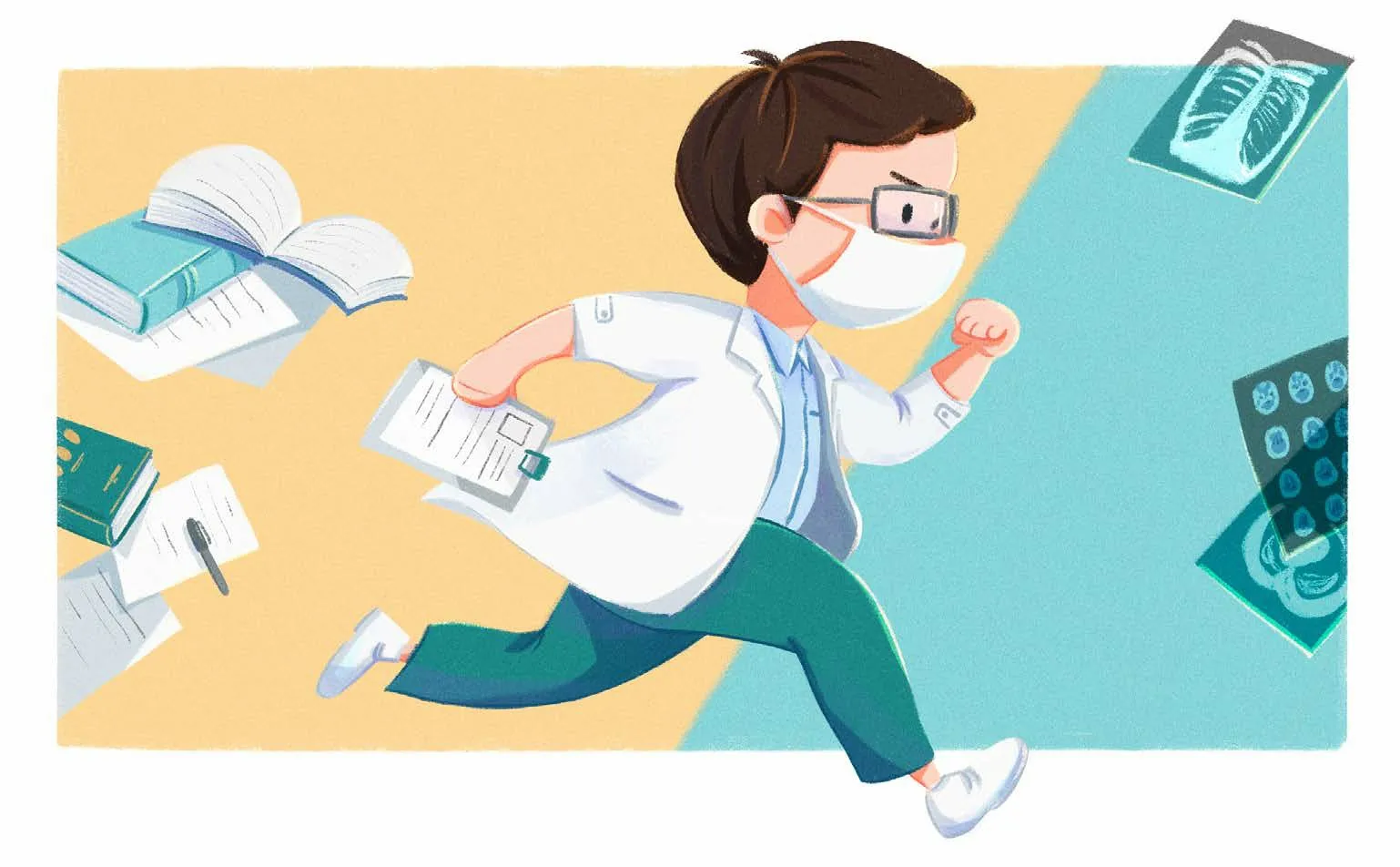Doctor’s Rules of Decision-Making
By Bo Shining
People often encounter problems while making decisions:incomplete information,inadequate time,and intimidating,life-or-death consequences may influence their decisions.
These types of problems are especially commonplace in hospitals.
Doctors can never wait until they have all the information about the disease before diagnosis and treatment.Instead,they have to decide on a treatment within a short period of time.Therefore,only those who can make quick decisions on the basis of limited information can be regarded as qualified doctors.This ability is not easy to come by;it stems from one’s analytical skills and clinical experience,both of which can only be acquired over time.
When it comes to analytical skills,doctors usually follow four rules in their decision-making while processing incomplete information.
Rule Number 1:The Law of Tang Sanzang (a master monk in the 16th century novel Journey to the West)
On their journey to the West,Tang Sanzang was often captured by demons and monsters.In most cases,his three disciples didn’t know what superpower the captor had or who they were.As long as Tang Sanzang was alive,Monkey King would find a way to rescue him;when Monkey King’s powers failed,he could turn to Guan Yin (Chinese translation of the Avalokiteśvara) for help;when Guan Yin was powerless,there was still Tathagata who could offer help.So long as Tang Sanzang was alive,there was surely a way.Similarly,in hospitals,as long as the patient is alive,there is hope.This is the Law of Tang Sanzang.

For example,I have had many patients in the ICU suffering from cardiac arrest,which could be caused by a number of things.However,in those few golden minutes when the patient’s life is at stake,the most important thing is not looking for the cause of cardiac arrest,but keeping them alive.Therefore,I focus on three critical indicators in the patient:heart rate,blood pressure,and respiration.If the patient’s heartbeat is unstable,I use medicine to keep it stable to avoid fatal arrhythmia;if the patient’s blood pressure is low,I use medicine to raise it to ensure that every organ is getting blood flow;if the patient has breathing problems,I immediately have the patient’s trachea intubated with a ventilator so as to provide them enough oxygen.
我们在做决策时,经常会遇到一些问题:首先,需要的辅助决策的信息不全面;其次,留给决策的时间往往有限;最后,决策带来的后果时常性命攸关。
在医院里,这种问题尤为常见。
医生永远都不可能等掌握了疾病的全部信息后再开始诊断和治疗,而必须在短时间内决定治疗方案。所以,只有具备了在信息不完备的情况下快速决策的能力,才算合格的医生,但具备这种能力非常不容易,因为它是建立在长期养成的思维逻辑和大量临床经验的基础上的。
思维逻辑方面,医生在信息不完备的情况下做决策,会遵循下面四条法则。
第一条:唐僧法则
在西天取经的路上,唐僧经常会被妖怪抓走。大多数情况下,他的几个徒弟都不知道这个妖怪有什么法力,是什么来头。但是只要唐僧不死,孙悟空就总有办法把他救回来。就算孙悟空救不了,还可以求助观世音;观世音不行,还有如来。所以只要唐僧活着,就有办法。
同样的道理,在医学上,只要先保证病人活着,就有希望。这就是唐僧法则。
比如,在ICU,我经常会遇到心搏骤停的病人,原因可能有无数个,但是,在病人生死攸关的那几分钟里,寻找心跳停止的原因不是最重要的,最重要的是先救命。所以,我最先关注的一定是病人的三个指标:心律、血压和呼吸。心律不稳,就用药物把心律维持在一个稳定的水平,处理致命性的心律失常;血压低,就用升压药物把血压升起来,从而保证身体每个器官都有血流;呼吸出现问题,就立刻对病人进行气管插管,用呼吸机帮助病人通气,给病人提供人体必需的氧气。这样,病人的命就保住了。
唐僧法则是医生做决策时的第一法则,也可以把它称为生命第一法则。这条法则的核心就是先把紧急事件转化为常规事件,从而给病人争取更多的时间,然后做进一步的判断和处理。
第二条:第一张骨牌法则
唐僧活下来了,但妖怪尚存,不解决,唐僧还是会遇到重重危机。这就要用到医生决策时的第二个法则:第一张骨牌法则。
The Law of Tang Sanzang is the first law doctors follow while making decisions.It can also be named the first law of life,which aims to buy the patient more time for further treatments.
Rule Number 2:The Domino Effect
Tang Sanzang has survived,but the monsters are still there.Unless the monsters are all killed,Tang Sanzang’s life is still in danger.Here is where the Domino Effect comes into play:when you push the first tile,all the tiles behind will fall one by one,for it is an interconnected system.Correspondingly,in the medical field,a patient’s symptoms are like fallen domino tiles laid in front of doctors,among which hides the most critical cause which leads to the relevant symptoms.
So the Domino Effect means that no matter how complicated the patient’s condition might look at first sight,we have to locate the first domino tile:the disease which explains all the symptoms.As a result,we can find the most effective treatment.This law is also referred to as the law of minimalism.
I once did a consultation session for an old lady in Urumqi City,who was in her 80s and was diagnosed with lung cancer and thyroid cancer a year ago.In addition,she suffered from pneumonia,breathing difficulties,bone pain,osteoporosis,bone spurs,and lumbar disc herniation.The patient was so depressed that she couldn’t stop sobbing and never slept.
Confronted with so many diseases and symptoms,what should I do? Which disease was the most critical one—the first domino tile?
I thought the first domino tile was lung cancer,which could explain the patient’s other symptoms.Lung cancer blocked the trachea,causing pneumonia,which then led to breathing difficulties;bone metastasis of lung cancer could cause severe bone pain,which gave the patient further problems like insomnia and depression.As for the other symptoms,they were all combined underlying diseases.
Therefore,I tested the blood circulation and tumor genes,which eventually located a specific lung cancer gene in her blood.Based on this result,I applied targeted therapy for lung cancer.Two weeks later,all her symptoms were relieved,which bought time for her follow-up treatment.
This rule might sound easy,but it is difficult to find the first domino tile in a pile of blocks.To find the first one,we need to know the third rule:the Sound of Hoofbeats.
Rule Number 3:The Sound of Hoofbeats

你或许玩过多米诺骨牌——只要推倒第一张骨牌,其他所有的骨牌都会相继倒下,它是一个相互联系的系统。相应地,在医学中,病人身上的各种不同症状就像是摆在医生面前的一张张倒下的多米诺骨牌,一定有一个最关键的原发病因导致了这些症状相继出现。
第一张骨牌法则就是,在诊断中,无论病人的病情有多么复杂,能用一种疾病解释病人出现的所有症状,就不考虑太多其他疾病;能用一种治疗方法给病人医治,就尽量避免所谓的面面俱到。这一法则通常也被称为简约法则。
我曾到乌鲁木齐给一位80 多岁的老太太会诊。她一年之前被诊断为肺癌、甲状腺癌。此外,她患有肺炎,呼吸困难,还伴有骨头疼、骨质疏松、骨刺、腰椎间盘突出等问题。她经常情绪低落,会不停地掉眼泪,整晚整晚睡不着觉。
这么多的疾病和症状就像摆在我面前的一张张多米诺骨牌。该怎么办呢?哪个病才是最关键的第一张骨牌呢?
我的判断是肺癌,因为它可以解释病人的所有症状。肺癌阻塞气管就会引起肺炎,肺炎会引起病人呼吸困难;肺癌骨转移,就会引起剧烈的骨痛,病人也会因为疼痛而失眠、抑郁。至于其他症状,都是合并存在的基础疾病。
所以,我让这位老人进行血液循环肿瘤基因的协测,终于在血液里找到特异性的肺癌基因。根据这个结果,我对她用了靶向性肺癌治疗药物。两周后,她所有的症状都得到缓解,为她的后续治疗赢得了时间。
这个法则听起来似乎并不难,但是想从一堆倒下的骨牌中找到第一张骨牌就不太容易了。想要找到第一张骨牌,就需要用到第三个法则:马蹄声法则。
第三条:马蹄声法则
医学院的老师经常会告诉学生们一句话:“如果你听到马蹄声,先想马,不要猜是什么马。”马蹄声法则说的其实是概率问题。医生决策时,要优先考虑大概率的常见病、多发病,根据概率大小,逐一落实,最后再考虑罕见病。
强调这个法则是因为人有惯性思维,而且对罕见的东西会有比较深的印象。一旦一个医生近期诊断或者接触过患有罕见病的病人,他就很容易产生思维定式。一旦出现思维定式,在以后的工作中遇到类似症状的时候,他就容易过高估计罕见病的可能性,从而忽略了常见病。
比如,咳嗽是一个常见的症状,引起咳嗽的原因很多,其中一种罕见情况是血管炎。如果医生近期见到过血管炎引起咳嗽的病例,那么下次再遇到咳嗽的病人,他就很容易先考虑血管炎,而忘记了这是罕见情况,应该放到最后考虑。正常情况下,医生应该优先考虑的病因是呼吸道感染、肺炎、气管炎;如果对方是老年病人,还要警惕是不是肿瘤原因;如果病人服用高血压药物,还要考虑是不是药物副作用原因。
所以马蹄声法则是为了避免主观偏差。
那么,是不是按照上述法则就可以完全避免医学的不确定性而快速做出正确决策了呢?不是。
Teachers in medical school often tell their students:When you hear the sound of hoofbeats,think of horses,not zebras.This rule is about probability.While making decisions,doctors should give priority to common and frequently-occurring diseases which have a higher probability,and consider rare diseases at the end.
This rule is emphasized because people tend to have a stereotyped way of thinking and usually have a deeper impression of rarer things.When a doctor has recently diagnosed a patient with a rare disease,they can easily develop a mindset of overestimating the possibility of rare diseases while encountering similar symptoms in new patients,thereby ignoring common diseases.
For example,coughing is a common symptom caused by many illnesses.One of the rare causes is vasculitis.If the doctor has seen a case of vasculitiscaused coughing lately,they could easily consider vasculitis first when encountering another coughing patient,forgetting that this is a rare case and should be considered lastly.Under normal circumstances,the causes doctors should give priority to are respiratory infections,pneumonia,and bronchitis.If the patient is elderly,the possibility of a tumor should be taken into account;if the patient is taking medicine,the side effect of the medicine should be checked.
So the law of hoofbeats is there to avoid subjective bias in diagnosis.
The three rules mentioned can only reduce the probability of making errors,but uncertainty still occurs frequently.According to statistics,even in Western countries where medicine is highly developed,the rate of misdiagnosis in emergency rooms is still as high as 10%-20%,and the rate of missed diagnosis can be as high as 25%.Why is that? Because even if those rules are followed,our subjective experiences still render deviations in our decisionmaking while facing uncertainty and urgency.
Rule Number 4:The Principle of Golf
The Principle of Golf is used to correct our subjective deviations.
In order to get the ball into the hole,golfers constantly adjust their stance and swinging angles.The same goes for doctors.From the very beginning,doctors need to adjust and readjust their judgments as well.
When a patient is first admitted to hospital,the admission diagnosis is the doctor’s initial decision.After hospitalization,the patient goes through further examinations,consultations,and treatments,on the basis of which the doctor can adjust and correct their initial decision with more information.When the patient is cured and discharged,the doctor can give a discharge diagnosis,which,in most cases,is not exactly the same as the admission diagnosis.
There are many methods doctors use in adjusting their decisions,such as the evidencebased approach,multidisciplinary treatment,or inviting experts of a certain field in other hospitals for collective consultation,so as to avoid errors caused by personal experience.All of these practices aim to avoid biases brought by one doctor’s personal subjective experience.
In the field of medicine,maintaining principles can help when confronting complex issues.Grasping these four rules can help us make better decisions in our daily life.
(FromLectures on General Medical Knowledge by Bo Shining,CITIC Press.Translation:Lu Qiongyao)

上述三个法则只能降低发生错误的概率,而不确定性还是会经常发生。据统计,即使是在医学高度发达的西方国家,急诊误诊率仍然高达10%~20%,漏诊率甚至高达25%。为什么呢?因为即使遵守了法则,面对巨大的不确定性和紧迫性,在快速决策的过程中,主观经验还是会带来偏差。
第四条:高尔夫法则
高尔夫法则就是用于纠正医生的主观偏差的。
打高尔夫的人为了让球最终进洞,会不断调整自己站立的位置和挥杆的角度。医生也一样,从最开始决策时,就需要不断校正自己的判断。
病人入院时有入院诊断,入院诊断就是医生最初给的决策。病人住院后,经过进一步检查、会诊、治疗,医生会根据这些信息对最初的决策进行校正。等到病人痊愈出院,医生还会给出出院诊断。大多数情况下,入院诊断和出院诊断并不完全一致。
医生在校正决策的过程中会用到很多方法,比如运用循证医学的方法寻找决策的最可靠的证据,比如组织多科室会诊避免个人经验带来的错误,比如邀请国内某个领域的专家会诊……这些都是为了避免医生个人主观经验带来的偏差。
在医学的复杂性面前,灵活带来的优势越来越小,原则带来的优势越来越大。掌握这四条法则,会为你在日常生活中的决策提供帮助。
(摘自《薄世宁医学通识讲义》中信出版社)

